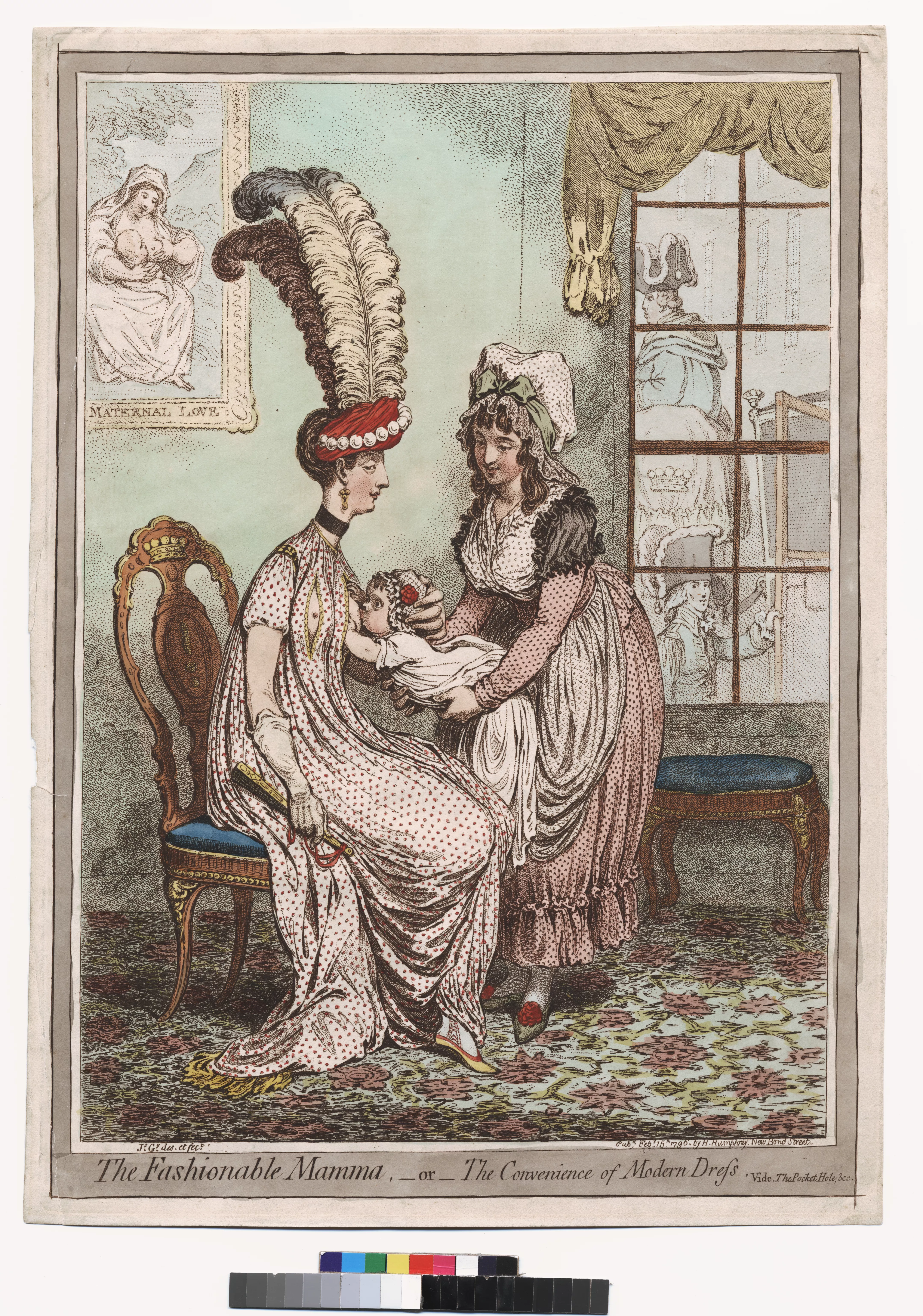Creation Date
15 February 1796
Medium
Genre
Description
A viscountess sits between a portrait of a peasant woman breastfeeding a baby, the frame of which reads “Maternal Love," and a window revealing a carriage waiting outside, its attendant holding its door open. The viscountess wears a loosely fitting polka-dot dress and a large feather headpiece. She sits with a fan in her right hand, which is relaxed alongside her hip, and her with her torso bent slightly forward to the baby nursing from a breast, which is exposed via slits in the dress. Her left hand cups the back of the baby’s head. Her eyes are cast downward and to the side, catching the viewer’s gaze. A maid holds the body of the baby and looks down at the nursing process.
The newest fashions at the time of this print’s publication included loosely fitting draping dresses and high feather headdresses. The pictorial irony here depends on “maternal love” as a following of popular aristocratic fashion. To leverage this irony, counterintuitive images share the space: the carriage waiting outside on one side of the background and the picture of the peasant woman breastfeeding her child in a natural setting on the other, the fan in one hand and the baby’s head in the other, suggest the gap between the presentation of maternal love as means to follow fashion, and the natural, organic maternal love as a result of necessity. The natural setting of the peasant woman’s portrait versus the fashionable domestic setting of the viscountess further highlights the difference between presented and intrinsic maternal love. While the angle of the maid’s pleasant looking face is mirrored by the attentive face of the peasant woman in the painting, the downcast gaze of the mother is directed not at the baby but at her fan. All of these contradictory images convey the irony in fashionability's convening to maternal love, or rather maternal love's convening to fashionability.
Hannah Humphrey’s print shop not only showed and sold Gillray’s caricatures that mocked the fashion priorities of the upper aristocracy, but also Heidhelhoff’s Gallery of Fashion plates. Caricature of morally questionable aristocratic fashion sought both to sairize and entertain satire and to participate in its dissemination to the masses.
Jean-Jacques Rosseau's writings made breast-feeding a fashionable practice for the British upper-class (K. Hart, James Gillray 47).
This print speaks to important cultural issues revolving around the relationship between fashion and domesticity. Moral reformers, threatened by the “laxity of manners” and corruptibility that coincided with an over-interest in fashion, deplored the loose draping gowns that put the woman’s body on display (D. Donald, Satirical Prints 102). In that the viscountess does not pretend to truly value her maternal love, and rather uses it to enhance her social, externally fashionable persona, Gillray aligns her true internal personality with the one-dimensional world of presentation, in this way criticizing the shallowness of wealthy aristocratic females in general. For the viscountess, the energy invested in maternal love is not actually in competition with the energy invested in maintaining a properly fashionable upper-class social life (depicted by the loose-fitting gown and the large feather headpiece, the a la mode nursing style introduced by Jean-Jacques Rosseau). The woman can nurse in the antechamber on her way out the door, without time-consuming and hindering change of dress procedures. Thus, the irony of fashion's assistance to maternal love, despite the moral reformers' antagonism of its moral transgressiveness, allows Gillray to satirize not only the shallow woman, but also the reformers’ efficacy.
Though this gap between external presentation and internal shallowness is not problematical for the viscountess, it is meant to be for the viewer, revealed thanks to the pointedly contrasted images of country maternal love and urban aristocratic maternal love. The growing city was an essential medium for the overzealousness fashionability (D. Donald, Satirical Prints 102), and the contrasting images, most notably the carriage versus the country setting in the peasant's portrait, here speak to Romantic culture’s obsession with the relationship between the city and country. This print also gestures to a more overarching belief in the fundamentality of women as moral exemplar in the domestic sphere, a position not only often seen in competition with social endeavors but also, paradoxically, believed to insure poblic order. The child's inheritance of the mother's morality points to the perpetuation and proliferation of the values engendered within the private sphere.
Publisher
Hannah Humphrey
Accession Number
796.2.15.1
Additional Information
Bibliography
Donald, Diana. The Age of Caricature: Satirical Prints in the Reign of George III. New Haven, CT: Yale University Press, 1996.
Godfrey, Richard. James Gillray: The Art of Caricature. London: Tate Gallery Publishing, 2001.
Hart, Katherine W. James Gillray: Prints by the Eighteenth Master of Caricature. Hanover: Hood Museum of Art, Dartmouth College, 2004.
Wright, Thomas, ed. The Works of James Gillray, the Caricaturist. London: Chatto and Windus, 1874.

